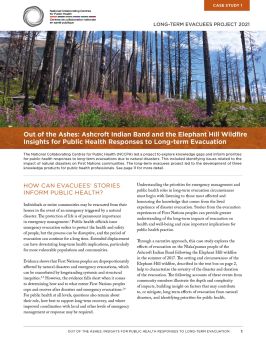Out of the ashes: Ashcroft Indian Band and the Elephant Hill wildfire – Insights for public health responses to long-term evacuation
Cette ressource est également disponible en français.
This document is part of a three-part series called Public Health Responses for Long-Term Evacuation and Recovery, produced by the National Collaborating Centres for Public Health (NCCPH). The goal of the project is to explore the long-term effects of evacuations due to natural disasters and associated public health responses. See below for links to the other documents in this series.
First Nations communities and evacuation
First Nations peoples are disproportionately affected by natural disasters. Repeated and extended evacuation from their communities has negative impacts on the health and well-being of First Nations peoples over the long-term.
Beyond immediate emergency response measures, a better understanding is needed of public health’s two-pronged role in these cases: on one hand, to address the health and social impacts of natural disasters and, on the other, to support long-term emergency planning and recovery in a coordinated and culturally safe way.
Case study
Based on first-person accounts from community members, this case study explores the process and impacts of evacuation on the Nlaka’pamux people of the Ashcroft Indian Band following the Elephant Hill wildfire in 2017.
The community felt unprepared for emergency response, having experienced administrative barriers to supports and a lack of continuity in health services. This resulted in high levels of confusion, stress and mistrust of health authorities in addition to other negative experiences: trauma, grief, loss, negative impacts on physical and mental health, increased substance use, inadequate housing and unhealthy environmental conditions.
Public health responses
Some of the critical insights to inform public health responses were focusing on First Nations’ identified needs, addressing psychological well-being and developing community-specific plans for emergency preparedness and recovery planning.
Another observation was that, when it comes to planning culturally safe and appropriate responses to evacuation due to natural disaster, meaningful relationships between public health and First Nations communities that pre-exist a natural disaster are key.
Use this resource to:
- facilitate discussion about First Nations communities at risk of evacuation due to natural disaster and how to develop meaningful relationships with those communities;
- identify emergency response and recovery plans currently in place for First Nations communities in your area and explore, with the community, the role of public health to support long-term recovery efforts; and
- develop a plan with the community for how public health can address the long-term health, social, environmental and cultural impacts of extended or repeated evacuations due to natural disaster.
Also in this series:
- Other Case Study: From the floodwaters: Flooding in Siksika First Nation (2021)
- Health and social impacts of long-term evacuation due to natural disasters in First Nations communities: A summary of lessons for public health (2021)
Related resources
Embedding equity into emergency operations: Strategies during COVID-19 & beyond (2020)
Public health emergency preparedness: A framework to promote resilience (2018)
Social participation: Synergies in systems strengthening & emergency response (2020)
Reference
National Collaborating Centres for Public Health. (2021). Out of the ashes: Ashcroft Indian Band and the Elephant Hill wildfire - Insights for a public health response to long-term evacuation (Case Study #1). Winnipeg, MB: NCCPH.
Tags: Environmental health, Indigenous health, Pandemic, Partner with other sectors, Other National Collaborating Centre, Document, Report / Document
